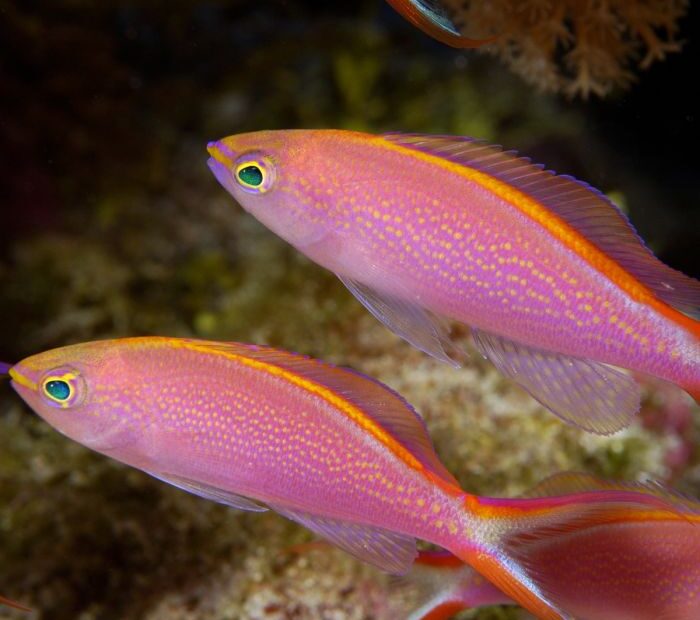The Princess Anthias (Pseudanthias smithvanizi), also known as the Princess Basslet or Scribbled Basslet, is a captivating marine fish admired for its vibrant coloration and graceful presence. Originating from the Western Pacific Ocean, this species is a sought-after addition for experienced aquarists aiming to enhance the visual appeal of their reef aquariums.
Key Information
• Small fish safe: ✅ Yes
• Small invert safe: ✅ Yes
• Coral safe: ✅ Yes
• Minimum tank size: 208 liters (55 gallons) for a single specimen; larger for groups
• Adult size: Up to 9.5 cm (3.7 inches)
• Diet: Carnivorous (zooplankton, enriched frozen mysis/brine shrimp, high-quality flake foods)
• Be aware of: Requires frequent feedings due to high metabolism. Best kept in harems (one male with multiple females). May be shy initially; provide ample hiding spots. Known to jump; ensure a secure lid. Avoid housing with aggressive tankmates.
Appearance and Coloration
The Princess Anthias boasts a striking appearance:
• Coloration: A rich, sapphire pink body adorned with golden-yellow spots and scribbles along the sides.
• Fins: The caudal fin is large, with males exhibiting elongated, filamentous lobes.
This vibrant coloration makes the Princess Anthias a visually appealing species in marine aquariums.
Natural Habitat and Behavior
In the wild, Princess Anthias are found in the Western Pacific, ranging from Indonesia to the Marshall Islands, northern Australia, and the Cocos-Keeling and Christmas Islands in the Indian Ocean. They inhabit:
• Habitat: Clear waters along steep drop-offs with moderate currents, typically at depths between 10 and 50 meters.
• Social Structure: They form harems consisting of one dominant male and multiple females. If the dominant male perishes, the largest female will often morph to take its place.
In captivity, they thrive in well-structured aquariums with ample hiding spots and open swimming areas.
Tank Requirements and Water Parameters
To ensure the well-being of Princess Anthias in captivity:
• Minimum Tank Size: A 55-gallon (208 liters) tank is suitable for a single specimen. For groups, a 180-gallon (681 liters) or larger aquarium is recommended.
• Water Parameters:
• Temperature: 72°F – 78°F (22°C – 25.5°C)
• pH: 8.1 – 8.4
• Specific Gravity: 1.020 – 1.025
• Aquascaping: Provide ample live rock formations to create hiding spots and territories, while ensuring open swimming spaces.
• Lighting: Initially prefer low to moderate lighting conditions but will adapt to stronger lighting over time.
• Water Movement: Moderate to strong, simulating their natural reef environment.
Maintaining stable water conditions is crucial for their health.
Diet and Feeding
Princess Anthias have a high metabolism and require frequent feedings:
• Diet: Primarily carnivorous, feeding on zooplankton in the wild. In captivity, offer:
• Enriched frozen mysis shrimp
• Enriched frozen brine shrimp
• High-quality flake foods
• Live foods (e.g., copepods, amphipods) can be beneficial, especially during acclimation.
• Feeding Frequency: Due to their constant activity and high metabolisms, they should be fed small amounts several times per day (at least three times daily) to maintain good health.
An attached refugium cultivating copepods and amphipods provides a steady supply of nutritious live food, which can be beneficial for this active planktivore.
Compatibility and Social Structure
Princess Anthias are social fish that thrive in groups:
• Social Structure: Best kept in harems consisting of one male and multiple females. Avoid keeping multiple males in the same tank, as it can lead to aggression.
• Temperament: Generally peaceful but may be shy, especially when first introduced. They should not be housed with overly aggressive species.
• Compatible Tank Mates: Suitable companions include other peaceful reef fish, such as gobies, blennies, and small wrasses. Avoid housing with aggressive or overly competitive feeders.
Providing a peaceful environment with compatible tank mates will help reduce stress and encourage natural behaviors.
Important Considerations
• Acclimation: Princess Anthias can be sensitive to changes in water parameters. Use a slow drip acclimation process to minimize stress.
• Lighting: Initially prefer low to moderate lighting conditions but will adapt to stronger lighting over time.
• Jumping: Known to jump, so a secure lid is essential.
• Feeding: Requires multiple feedings throughout the day due to high metabolism.
With proper care and attention to their specific needs, Princess Anthias can be a stunning and rewarding addition to a marine aquarium.
